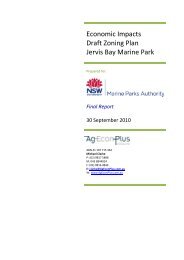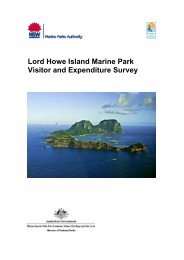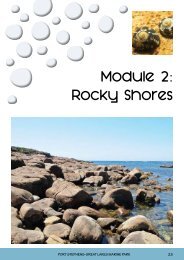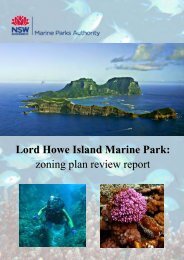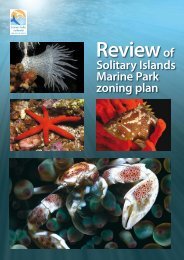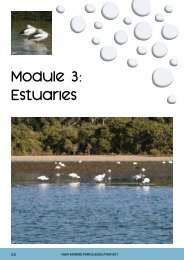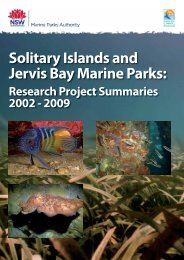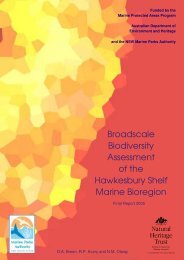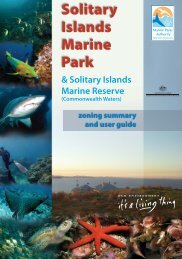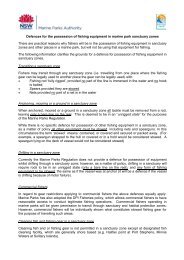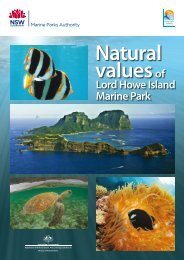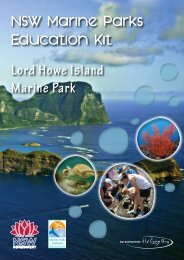Natural values of the Solitary Islands Marine Park - Marine Parks ...
Natural values of the Solitary Islands Marine Park - Marine Parks ...
Natural values of the Solitary Islands Marine Park - Marine Parks ...
- No tags were found...
Create successful ePaper yourself
Turn your PDF publications into a flip-book with our unique Google optimized e-Paper software.
16 <strong>Natural</strong> <strong>values</strong> <strong>of</strong> <strong>the</strong> <strong>Solitary</strong> <strong>Islands</strong> <strong>Marine</strong> <strong>Park</strong>Figure 16.Shallow inshore Eckloniadominated reef.Figure 17.Average percentage <strong>of</strong>hard coral cover at 16sites on mid-shelf reefssurveyed in 2002, 2004 and2006.diversity is greatest round North West <strong>Solitary</strong> Islandand coral cover is highest round Split <strong>Solitary</strong> Islandand South West <strong>Solitary</strong> Island.As benthic assemblages are influenced by exposureto waves and currents, corals and o<strong>the</strong>r fragileassemblages generally have greater densities on <strong>the</strong>more sheltered western and north-western sides<strong>of</strong> <strong>the</strong> islands. However, as <strong>the</strong> islands are small, noarea is fully sheltered, and <strong>the</strong> same aspect at twodifferent islands can contain very different dominantsessile assemblages (Smith and Edgar 1999). Despitefine-scale differences in <strong>the</strong> distribution <strong>of</strong> <strong>the</strong> mainhabitat types such as kelp and coral, most habitatsare generally present around each island. However,<strong>the</strong> species in each habitat type round each islandare somewhat different.Coral cover on <strong>the</strong>se mid-shelf reefs varies betweenand within sites, and between reefs over time(Figure 17) (Malcolm unpubl. data). This is mostlikely due to variability in natural processes such asgrowth, recruitment, competition and predation.O<strong>the</strong>r influences include mortality due to bleachingand disease, storm removal <strong>of</strong> coral, and possiblylocalised competition with spreading corallimorphs(species that resemble coral but do not have askeleton and have tentacles, <strong>of</strong>ten in radiating rows)at some sites. It is not clear if or by how much <strong>the</strong>seprocesses are influenced by human activity.A spreading coral disease, recently termed Subtropical White Syndrome (Dalton et al2007), that can kill Turbinaria spp. and Acropora solitaryensis in particular, is present in <strong>the</strong>marine park (Dalton 2003) (Figure 18). A reduction in coral cover at South West <strong>Solitary</strong>Island during 2002 was partly due to this disease (Edgar et al 2003).The coral assemblages in <strong>the</strong> marine park are formed as a veneer over rock (Figure 19).Although <strong>the</strong>se can be relatively diverse – 91 hard coral species have been recorded in<strong>the</strong> marine park – and can have a high percentage <strong>of</strong> cover (e.g. <strong>the</strong> mean coral coverat Chopper Rock is about 45%), carbonate reef-building by corals and o<strong>the</strong>r carbonateproducing plants and animals does not occur in <strong>the</strong> marine park.Settlement patterns <strong>of</strong> mobile invertebrates aroundNorth West <strong>Solitary</strong> Island are highly variable overdifferent spatial scales, and consistently differfrom those around <strong>the</strong> <strong>of</strong>fshore islands. Samplesfrom North West <strong>Solitary</strong> Island are dominatedby an assemblage <strong>of</strong> polychaetes (segmentedmarine worms) and bivalve molluscs, with <strong>the</strong>bivalve Hiatella australis, in particular, being highlyabundant. Although a few species are mostlyresponsible for differences in <strong>the</strong> spatial patterns,many rare species also contribute to <strong>the</strong> overalldiversity <strong>of</strong> <strong>the</strong> area (Rule and Smith 2005). Thereare also seasonal patterns in species recruitment



